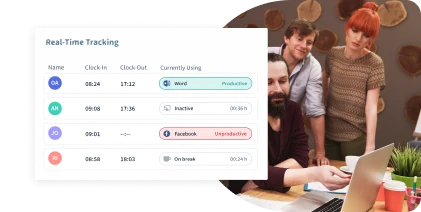Table of Contents
Employee burnout is a growing concern in today’s workplaces, affecting individuals and organizations.
Nearly 79% of employees have experienced burnout at work, leading to the following issues at the workplace:
- Decreased productivity
- Increased absenteeism
- High turnover rates
- Decline in employee morale
- More stress levels
In this blog post, we’ll discuss the following key things in detail:
- What is Employee burnout?
- Signs of burnout
- Strategies to prevent it in its early stages
This will help you to keep your team happy and productive.
Let’s dive in:
What is Employee Burnout?
Employee burnout is when someone feels extremely exhausted, stressed, and overwhelmed because of their job.
It can happen when a person is dealing with the following circumstances:
- Much work to do
- feels unappreciated
- Doesn’t have enough time to relax
It’s essential to identify the signs of burnout and take steps to prevent it, like taking breaks, seeking support, and finding ways to reduce work stress.
The Silent Nature of Burnout
Burnout can be sneaky because it often hides in the shadows. It’s called “silent” because employees who are going through it might not talk about it or show obvious signs.
They keep going, but inside, they’re feeling exhausted and overwhelmed.
This quiet struggle can make it hard for them to ask for help or for others to notice they need support.
That’s why paying attention to even the subtle changes in people’s behavior or mood is essential to spot burnout and help them before it worsens.
Some Common Signs of Burnout
Read the below infographics to learn about some common signs of employee burnout.

Top 5 Ways to Deal with the Burnout in Early Stages
1. Activity Monitoring
Activity monitoring involves keeping an eye on how you spend your time at work. It’s like having a friendly reminder to take breaks and switch tasks when needed.
By watching your activities, you can make sure you don’t overdo it, which can help reduce stress and prevent burnout.
Activity monitoring is all about making sure that your employees are using their work time effectively and not pushing too hard.
Workstatus can be your helpful partner in achieving this.
App & Website Monitoring: Workstatus tracks the apps and websites you use during work hours. This way, you can see where your team’s time goes and identify any distractions that may contribute to burnout. It’s like having a digital timekeeper.
Active Screenshots: Workstatus takes periodic screenshots of your screen while you work. It can help you visualize how you spend your time and ensure you stay on task. It’s like taking snapshots of your workday.
Idle Time Tracker: You can easily keep tabs on your idle time. It means it knows when you’re away from your computer or not actively working. It’s like an automatic break timer, reminding you to step out and recharge, reducing the risk of burnout.

2. Flexible Work Arrangements
Flexible work arrangements mean you have freedom in how and when you work. It’s like having the option to choose your work hours or even work from different places.
This flexibility can make balancing your work and personal life more manageable, reducing the chances of feeling overwhelmed and burned out.
Flexible work arrangements can make your work-life balance much better. Workstatus has some great features to help you make the most of this flexibility.
Automated Scheduling: You can now automatically schedule your work hours. It’s like having a personal assistant that plans your work time and helps you to assign shifts based on roles.
Shift Reminders: With Workstatus, teams can get reminders for upcoming shifts. It’s like a friendly nudge to start work or take a break when it’s time. It helps everyone stay organized and not overwork, reducing burnout risks.
Absent Alerts: If you cannot work as planned, Workstatus can send alerts. It’s like a safety net, ensuring managers know when their team members can’t make it so they can adjust. It reduces stress and keeps work manageable.

3. Recognise & Reward Your Employees
Recognizing and rewarding employees means showing appreciation for their hard work. It’s like giving a thumbs-up or a unique “good job” shoutout.
When employees feel appreciated and valued, it boosts their motivation and morale, making burnout less likely.
Recognizing and rewarding your employees is super important!
It’s like telling them, “Hey, you’re doing a great job, and we appreciate you.”
This simple act can make a big difference.
Now, let’s talk about how a tool like Workstatus can help businesses do this even better with the help of the following features:
Performance Tracking: Managers can monitor how well each employee is doing. It’s like having a scoreboard for work! When managers know who’s excelling, they can give them a pat on the back or a shoutout to acknowledge their hard work.
Productivity Calculator: The productivity calculator can help with that. It’s like a magic tool that measures how much stuff is getting done. When employees see their productivity increase, they feel proud, and managers can recognize their efforts by saying, “Great job, team!”
Habit Tracker: The habit tracker helps employees and managers keep track of good work habits. When someone consistently shows up on time or goes the extra mile, it’s like building a positive work habit. You can reward these habits, which motivates employees to keep up the excellent work.

4. Time Tracking
Time tracking is about keeping a record of how much time you spend on your tasks and projects. It’s similar to keeping a diary of your work hours.
By keeping track of your time, you can see if you’re working too much and adjust your schedule to prevent burnout.
Time tracking is like keeping a journal of the hours you spend on your work. It’s a great way to ensure you’re not overdoing it and heading towards burnout.
Now, let’s see how Workstatus can help businesses and managers with time tracking:
Online Timesheets: Workstatus provides an automatic way to log in and record when you start and finish tasks. It makes it simple to see how much time you spend on different projects.
Automated Reports: Workstatus is like an intelligent assistant that can generate reports for you. Managers love this feature because it helps them monitor the team’s time, activity, and productivity without any effort.
Task Prioritization: You can prioritize your tasks, like assigning the important ones at the top of your to-do list. It helps you focus on what matters, and managers can see what tasks are getting done first.

5. Foster a Supportive Work Environment
A supportive work environment means having colleagues and bosses who are there for each other. It’s like having a team that helps you when things are hard.
In this kind of workplace, handling stress and avoiding getting too tired is easier because you know you have others to share the tough times with.
Closing Thoughts
You must say “good job” to your coworkers and manage your time well.
This helps make everyone happ y and work better together. It also prevents people from getting tired and helps us all do well.
So, don’t forget to compliment and use tools like Workstatus to make work easier!
FAQs
Ques: What is burnout, and why should I be concerned about it in my team?
Ans: Burnout is a state of physical and emotional exhaustion caused by prolonged stress. It can lead to decreased productivity and health issues. Recognizing it in your team is crucial to maintain a healthy and efficient work environment.
Ques: How can Workstatus help in preventing burnout?
Ans: Workstatus offers time tracking, task prioritization, and performance monitoring features. These tools help managers identify workload imbalances and provide support to prevent burnout.
Ques: How do I approach an employee I suspect is experiencing burnout?
Ans: Start an open conversation, express concern, and listen actively. Offer support, adjust workloads if possible, and encourage self-care. Consider involving HR or a counselor if needed.









